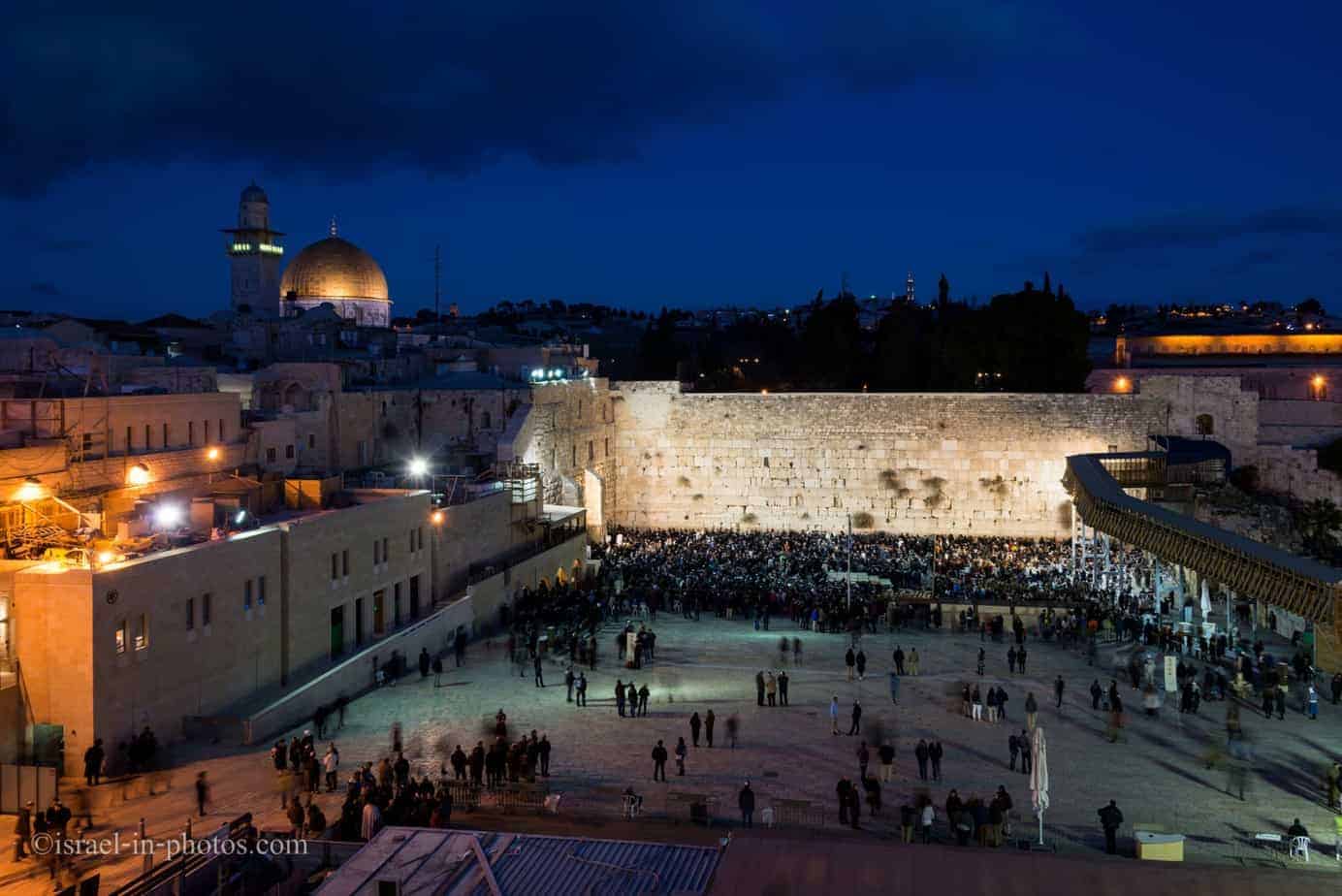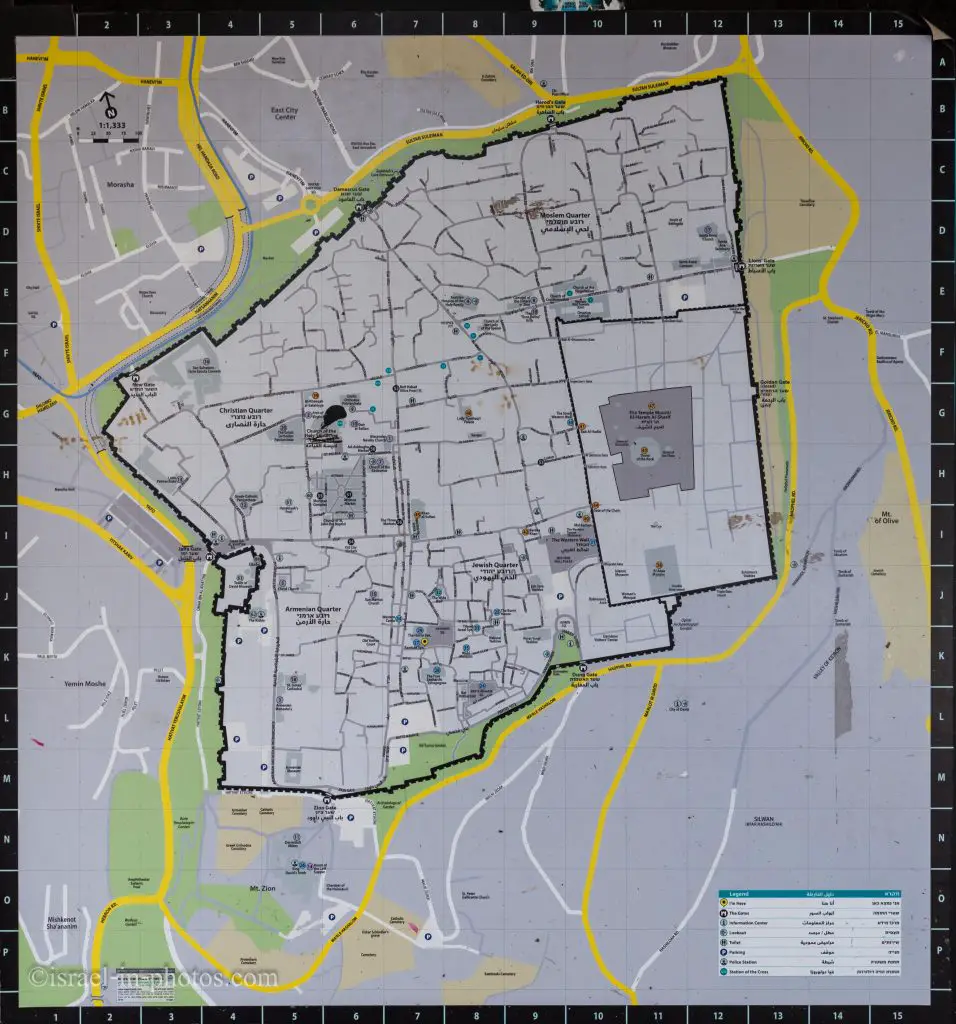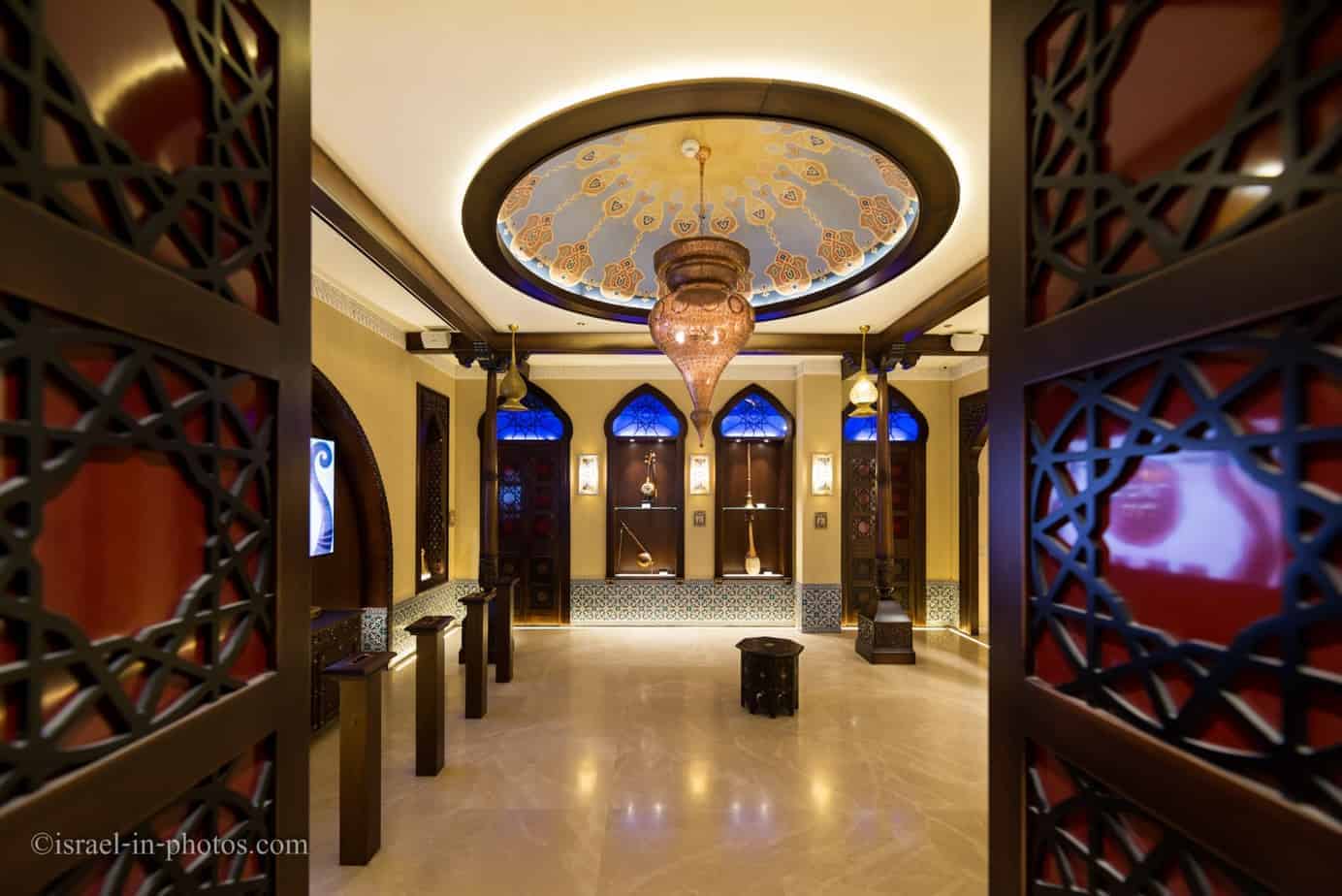Western Wall, Jerusalem – Visitors Guide with All Info
Western Wall (Wailing Wall, Kotel) is an ancient wall in the Old City of Jerusalem. It is the holiest place for Jews.
Also, do you know the connection between Star Trek and the Western Wall? You will find the answer at the end of this post.
Table of Contents
- 1 About the Kotel
- 2 Map
- 3 Directions
- 4 Restrooms
- 5 Different Names
- 6 The Western Wall
- 7 Kotel
- 8 The Wailing Wall
- 9 History
- 10 What is the Significance of the Kotel?
- 11 Opening Hours
- 12 Rules – Code of Conduct
- 13 Can Tourists Visit the Wailing Wall?
- 14 Prayers – Notes
- 15 What Happens to the Prayers in the Wailing Wall?
- 16 Events
- 17 When to Visit the Western Wall?
- 18 Tours
- 19 How Tall is the Western Wall?
- 20 Western Wall Tunnels
- 21 Taps and Drinking Water
- 22 Are there any Time Constraints?
- 23 Walking Backwards
- 24 Star Trek
- 25 Live Cam
- 26 Common Questions
- 27 Summary
About the Kotel
The Western Wall, Wailing Wall or Kotel is an ancient limestone wall in the Old City of Jerusalem. The wall was originally erected as part of the expansion of the Second Jewish Temple. Herod the Great begun the construction, which resulted in the encasement of the natural, steep hill known to Jews and Christians as the Temple Mount. He built a large rectangular structure topped by a huge flat platform, thus creating more space for the Temple itself and its auxiliary buildings.
The Western Wall is considered holy due to its connection to the Temple Mount. Because of the Temple Mount entry restrictions, the Wall is the holiest place where Jews are permitted to pray.
Source: Wikipedia
Map
Western Wall is located within the Old City Of Jerusalem. Dung Gate is the closest, but you can reach it from any entrance.
Directions for drivers: Link to Waze and Link to Google Maps
Directions for public transport: Link to Moovit
Interactive map of the area:
You can find the following map in several places in the Old City of Jerusalem.
Note: You can click on the map to enlarge it.
On the map above, the Western Wall is marked as #31 in square I10.
Directions
There are three entrances to the Western Wall plaza. And each entry is also an exit. Two of them are near Dung Gate, and one is in front of the Kotel (if you stand near the man’s area and turn around, you will see an entry on top of the stairs behind you). And though the Dung gate is the closest one, since you will probably visit other sites in the Old City, you can use any entrance to reach the Western Wall. For detailed directions, check the Old City Of Jerusalem guide.
Restrooms
There are big restrooms near the men’s entrance to the Wailing Wall. If you turn your back to the men’s entry and walk about 30 meters towards the stairs, you will see the toilets to your right.
Different Names
Before discussing the history and other interesting facts, let’s talk about the names. The most popular names are The Western Wall, Wailing Wall, and Kotel. And they all refer to the same place. What do they mean? We will discuss each of them in the following sections.
The Western Wall
When Herod the Great started expanding the Second Jewish Temple, he understood that more space was required (for the Temple itself and its auxiliary buildings). Thus they used the natural, steep hill known as the Temple Mount and created a large rectangular structure topped by a vast flat platform. And around this compound, they built a wall. The Western Wall got its name because it was to the West of the Temple.
Kotel
Most Israeli use the word Kotel. Kotel is a synonym for the word wall in Hebrew. Thus, if you talk to locals, and they do not understand you, use the word Kotel.
The Wailing Wall
There is an old joke in Israel. And it tells about an old Jew that comes to Israel and wants to visit the Kotel. But he forgets the name and says to the taxi driver: “Take me to the place where all Jews cry.” And the driver took him to the Government Tax Agency.
As they say, there is a grain of truth in every joke. The Western Wall became known as The Wailing Wall in other languages due to seeing Jews crying and praying near the Kotel. But in Israel, people do not say The Wailing Wall. And many probably will not understand you if you use this term.
History
In this section, I will not list the entire history. Instead, I will only mention the beginning and current status. The following quotes were taken from Wikipedia. If you want additional historical data, you can find it there.
But before we dive into history, I want to show several photos in this context. These are images of the Second Temple Model from the Israel Museum.
Note: you can click on the image to enlarge it.
Construction and Destruction of the Temple (19 BCE – 70 CE)
According to the Hebrew Bible, Solomon’s Temple was built atop what is known as the Temple Mount in the 10th century BCE and destroyed by the Babylonians in 586 BCE, and the Second Temple completed and dedicated in 516 BCE.
Around 19 BCE Herod the Great began a massive expansion project on the Temple Mount. In addition to fully rebuilding and enlarging the Temple, he artificially expanded the platform on which it stood, doubling it in size. Today’s Western Wall formed part of the retaining perimeter wall of this platform.
In 2011, Israeli archaeologists announced the surprising discovery of Roman coins minted well after Herod’s death, found under the foundation stones of the wall. The excavators came upon the coins inside a ritual bath that predates Herod’s building project, which was filled in to create an even base for the wall and was located under its southern section. That seems to indicate that Herod did not finish building the entire wall by the time of his death in 4 BCE. The find confirms the description by historian Josephus Flavius, which states that construction was finished only during the reign of King Agrippa II, Herod’s great-grandson.
Given Josephus’ information, the surprise mainly regarded the fact that an unfinished retaining wall in this area could also mean that at least parts of the splendid Royal Stoa and the monumental staircase leading up to it could not have been completed during Herod’s lifetime. Also surprising was the fact that the usually very thorough Herodian builders had cut corners by filling in the ritual bath, rather than placing the foundation course directly onto the much firmer bedrock. Some scholars are doubtful of the interpretation and have offered alternative explanations, such as, for example, later repair work.
Herod’s Temple was destroyed by the Romans, along with the rest of Jerusalem, in 70 CE, during the First Jewish–Roman War.
Israeli Rule (1967 – present)
Following Israel’s victory during the 1967 Six-Day War, the Western Wall came under Israeli control. Brigadier Rabbi Shlomo Goren proclaimed after its capture that “Israel would never again relinquish the Wall”, a stance supported by Israeli Minister for Defence Moshe Dayan and Chief of Staff General Yitzhak Rabin.
Forty-eight hours after capturing the wall, the military, without explicit government order, hastily proceeded to demolish the entire Moroccan Quarter, which stood 4 meters (13 ft) from the Wall. The Sheikh Eid Mosque, which was built over one of Jerusalem’s oldest Islamic schools, the Afdiliyeh, named after one of Saladin’s sons, was pulled down to make way for the plaza. It was one of three or four that survived from Saladin’s time. Six hundred fifty people consisting of 106 Arab families, were ordered to leave their homes at night. When they refused, bulldozers began to demolish the buildings with people still inside, killing one person and injuring several others.
According to Eyal Weizman, Chaim Herzog, who later became Israel’s sixth president, took much of the credit for the destruction of the neighborhood:
“When we visited the Wailing Wall, we found a toilet attached to it … we decided to remove it, and from this, we came to the conclusion that we could evacuate the entire area in front of the Wailing Wall … a historical opportunity that will never return … We knew that the following Saturday, June 14, would be the Jewish festival of Shavuot and that many will want to come to pray … it all had to be completed by then.
The narrow pavement, which could accommodate a maximum of 12,000 per day, was transformed into an enormous plaza that could hold more than 400,000.
Several months later, the pavement close to the wall was excavated to a depth of two and a half meters, exposing an additional two courses of large stones.

What is the Significance of the Kotel?
Kotel is the last remnant of the Temple. Thus it is considered holy. And due to the Temple Mount entry restrictions, the Wall is the most sacred place (the closest to the Holy of Holies) where Jews are permitted to pray.
We all know that the Western Wall, the Kotel, is the most significant site in the world for the Jewish people. All of us know that it is the last remnant of our Temple. We also know that Jews from around the world gather here to pray. People write notes to G-d and place them between the ancient stones of the Wall.
But did you know that many important events took place on Mount Moriah, later known as the Temple Mount?
Mount Moriah, according to Jewish tradition, is the place where many pivotal events in Jewish history took place. Traditionally, creation of the world began from the Foundation Stone at the peak of the mountain. It is also where Adam, the first human, was created.
When Abraham was commanded to prepare his son Isaac for sacrifice, the father and son went up to “the place that G-d chooses” – Mount Moriah, and to its peak – the Foundation Stone – where the binding of Isaac took place.
Jacob’s dream (of angels ascending and descending a ladder) is linked to this mountain.
Later on, the Holy of Holies – the core and heart of the First and Second Temples – was built around the Foundation Stone.
Source: thekotel.org

Opening Hours
The Western Wall Prayer Plaza is always open (24×7).
Rules – Code of Conduct
As in all religious sites, modest clothing is required. That means covered shoulders and shorts/skirts, at least to the knees. Men must cover their heads when approaching the Western Wall. You can wear a hat or a kippah. You can take one for free at a stand near the men’s entrance if you do not have a kippah. And you are also requested to return the yarmulke when you leave.

Since I mentioned men’s entry, you should know that women and men must pray in separate sections. A fence divides the Western Wall into two parts: one for men (the larger area) and the other for women.
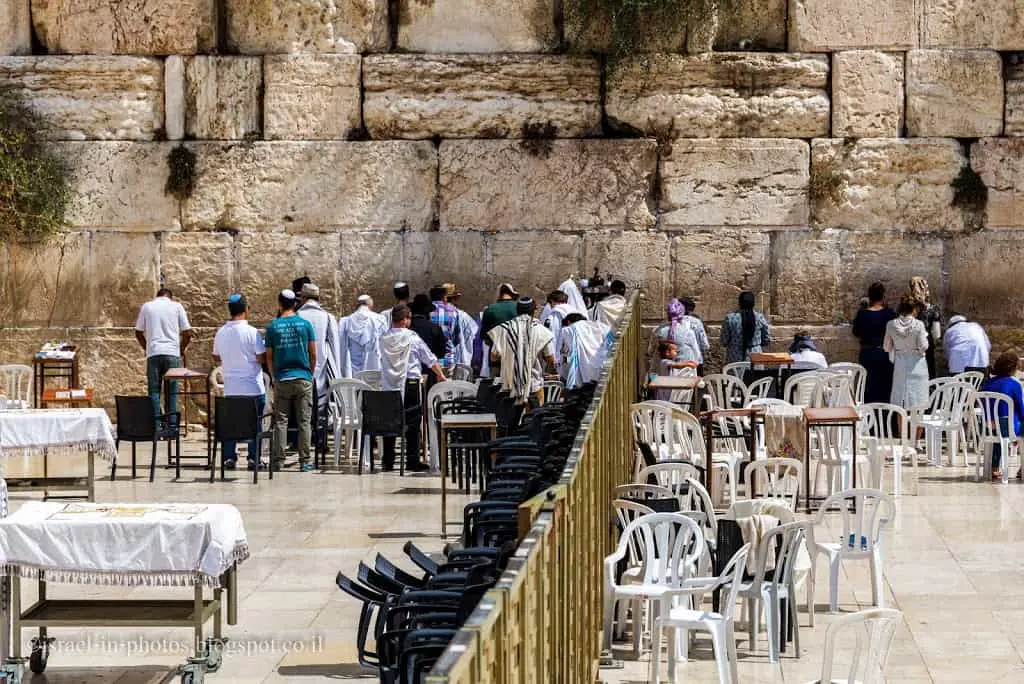
The Western Wall is a holy site. Please show respect to the site and those who pray here: Please refrain from eating, smoking, lighting candles, and dress appropriately.
On Jewish Sabbath and Holidays, refrain from using electronic devices, using amplification systems, and taking pictures.
Source: official website
Can Tourists Visit the Wailing Wall?
Yes. Many tourists of different religions visited the Kotel and prayed there. For example, Pope John Paul II, Benedict XVI, Barack Obama, and Donal Trump visited the Western Wall.
As far as I know, you cannot fly drones above the Old City. But you can always take a photo of a model. Here is a picture of the Western Wall and Temple Mount from Mini Israel.
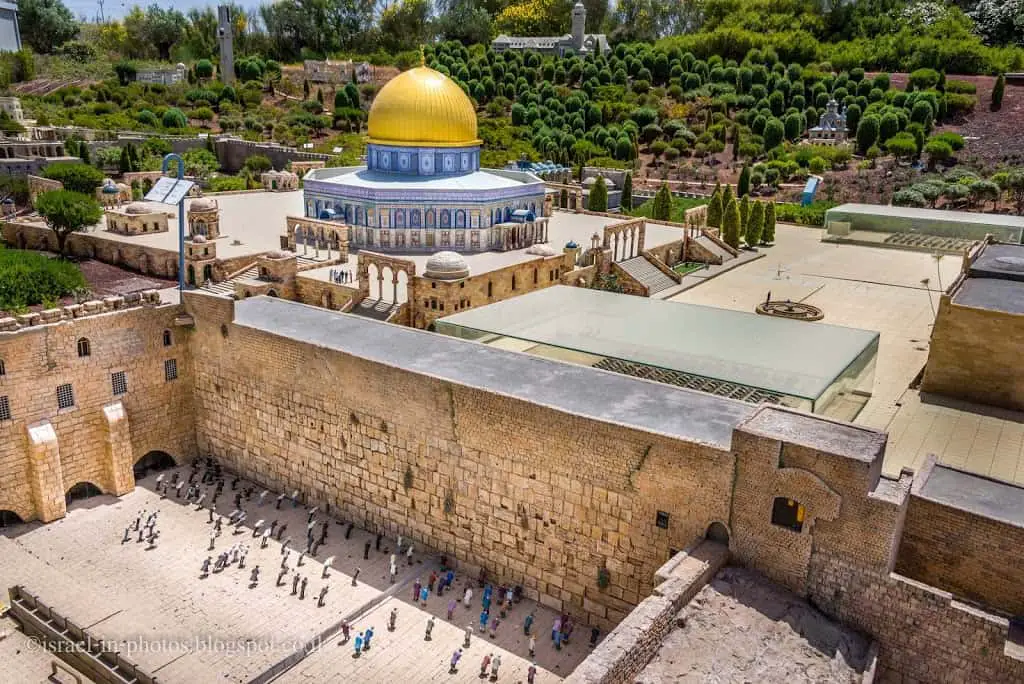
Prayers – Notes
People of all faiths pray at the Western Wall. Moreover, they place notes (slips of paper containing written prayers) in the Wall’s cracks. It is an old tradition caused by the belief that a Divine Presence rests upon the Wall.
Placing notes in the Western Wall refers to the practice of placing slips of paper containing written prayers to God into the cracks of the Western Wall, a Jewish holy site in the Old City of Jerusalem.
It is claimed that the occurrence of such a phenomenon dates from the early 18th century and stems from the Jewish tradition that the Divine Presence rests upon the Western Wall. There is however a dispute as to whether it is permissible according to Jewish law to insert slips of paper into the crevices. Some argue that the practice debases the holiness of the Wall and that the placement of notes should be discontinued.
Over a million notes are placed each year in what has become a custom, not only for tourists but also for high-profile dignitaries visiting Israel from abroad.
Source: Wikipedia
Today you can even send a virtual note. If you cannot visit, you can fill out a form on the official site, and they will put a message on your behalf.
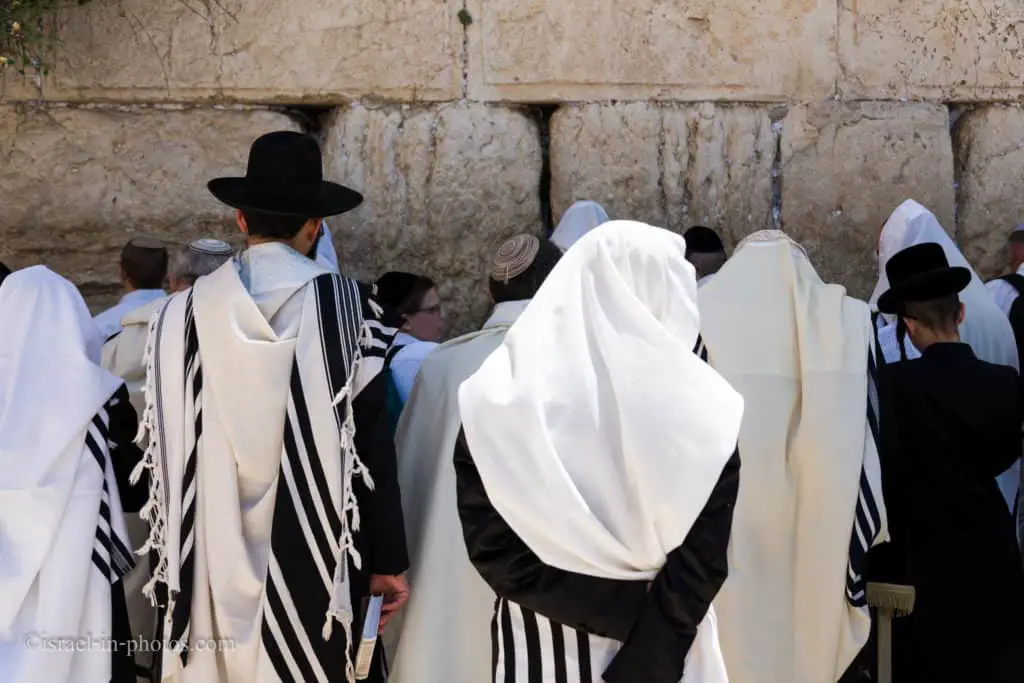
What Happens to the Prayers in the Wailing Wall?
Over a million notes are placed each year. Do they run out of space? Yes, they do. Thus, they collect the notes left in the Wall twice a year and bury them in the Jewish cemetery on the Mount of Olives.
According to Jewish law, prayer notes may not be thrown away. There is a difference of opinion as to whether they should be burned or buried. According to Rabbi Shmuel Rabinovitch, Rabbi of the Western Wall and author of Minhagei HaKotel, a book of halakhot about the Western Wall, burning is a “pure” way to deal with the notes, but burying them is more honorable. Rabinovitch further states that the letters are buried because they have the status of letters to God. Twice a year, Rabinovitch and his assistants collect the notes left in the Wall and bury them in the Jewish cemetery on the Mount of Olives.
Source: Wikipedia

Events
Like many Israeli, I celebrated my Bar Mitzvah at the Western Wall. But the plaza is used not only for Bar and Bat Mitzvah. It is also utilized for worship and other public gatherings, such as swearing-in ceremonies of IDF soldiers who completed the basic training course. Also, many Jews visit the Kotel during the holidays. Which ones? We will answer this question in the next section.
When to Visit the Western Wall?
Western Wall plaza is always open. But if you want to have a memorable experience, I suggest visiting the site during one of the occasions mentioned in this section.
Kabbalat Shabbat
Kabbalat Shabbat is a prayer that welcomes the arrival of Saturday. And each Friday evening, just after sunset, you can go to the Western Wall to see Kabbalat Shabbat. During a Weekend in Jerusalem, we went for a Kabbalat Shabbat at Western Wall. And it was a powerful experience. There was not only praying but also dancing and singing.
In the following photo, you can see the movement and dancing of the people.
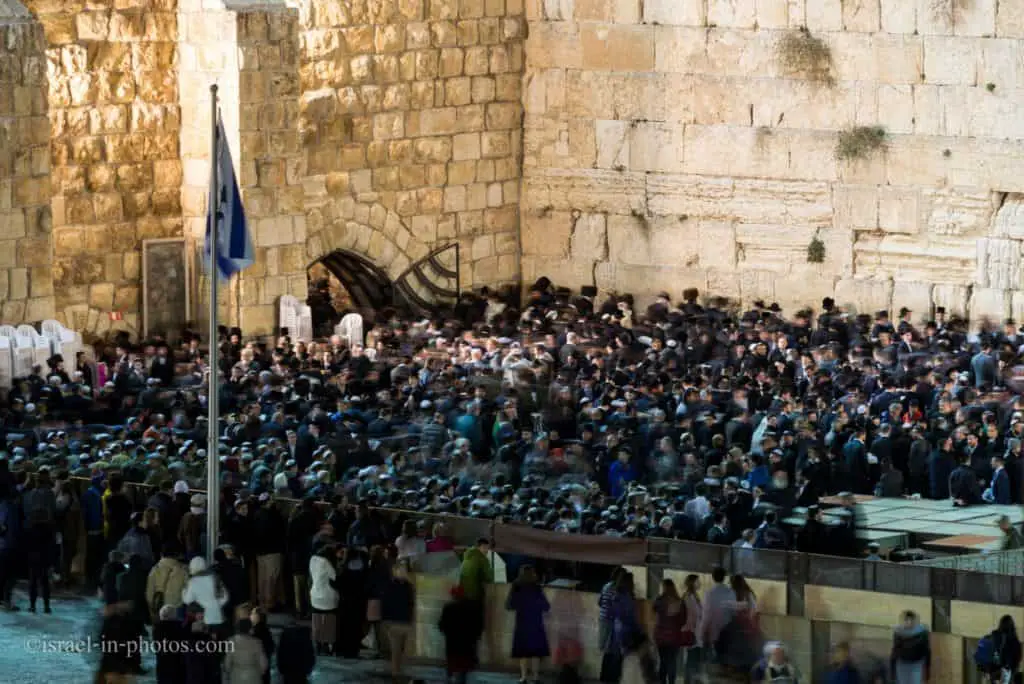
Three Pilgrimage Festivals – Shalosh Regalim
Three Pilgrimage Festivals, Shalosh Regalim in Hebrew, are three Jewish festivals. And during those festivals, which are Sukkot, Pesach (Passover), and Shavuot (Pentecost), ancient Israelites living in the Kingdom of Judah would make a pilgrimage to the Temple in Jerusalem.
After the destruction of the Second Temple and until the building of the Third Temple, the actual pilgrimages are no longer obligatory upon Jews, and no longer take place on a national scale. During synagogue services, the related passages describing the holiday being observed are read aloud from a Torah scroll on the bimah (platform) used at the center of the synagogue services. During the Jewish holidays in modern-day Israel, many Jews living in or near Jerusalem make an effort to attend prayer services at the Western Wall emulating the ancient pilgrimages in some small fashion.
Source: Wikipedia
Birkat Kohanim at the Western Wall
Birkat Kohanim takes place twice a year – on Chol HaMoed (the intermediate days) of Sukkos and Passover.
Tisha B’Av
During Tisha B’Av, thousands come to the Kotel. Tisha B’Av is an annual fast day in Judaism, on which many disasters in Jewish history occurred. The major tragedies are the destruction of the first and the second Temples.
Tisha B’Av falls in July or August in the Gregorian calendar. And during this fast day, many sit on the floor (not on chairs), as is customary during mourning days.
The Month of Selichot
During the month of Elul, many visit the Wailing Wall to ask for forgiveness. And I would suggest considering joining Selichot Tour. To learn more about these tours, check out the link to our experience from Selichot Tour.
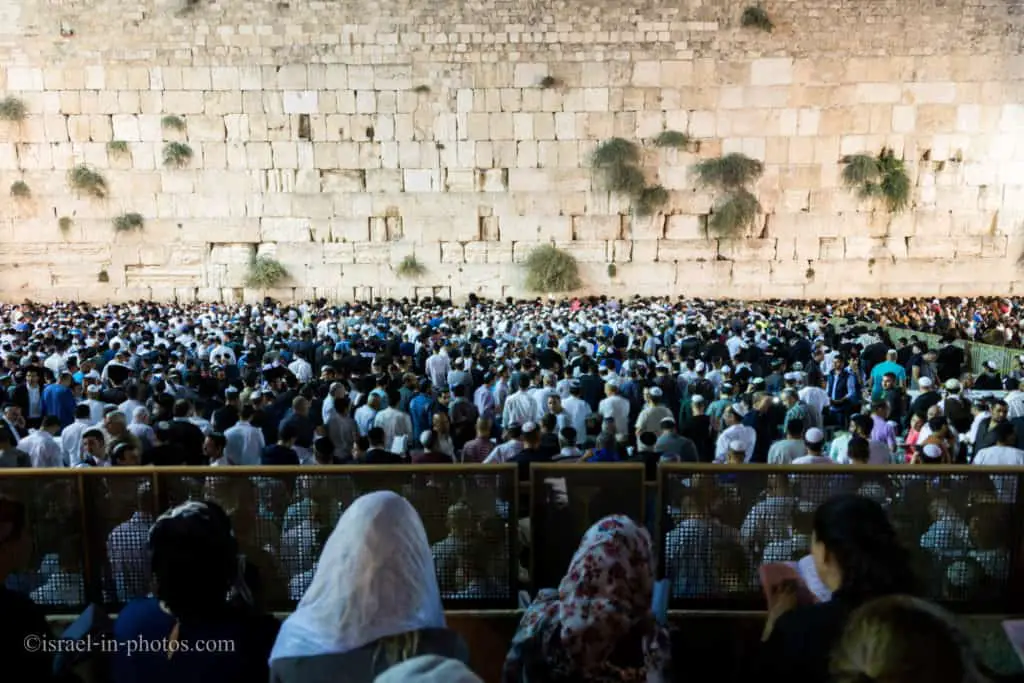
Jerusalem Day
Jerusalem Day is a national holiday commemorating the reunification of Jerusalem. During the 1967 Six-Day War, Israel gained control over the Old City and the Western Wall. There are state ceremonies and memorial services throughout Israel, including the Kotel.
Hanukkah
Hanukkah is not one of the Shalosh Regalim, and it is a less popular time for visiting the Western Wall. But during Hanukkah, you can join one of the Hanukkah Tours and see the big Hanukkiah next to the Kotel.
Here are my impressions from different Hanukkah Tours.
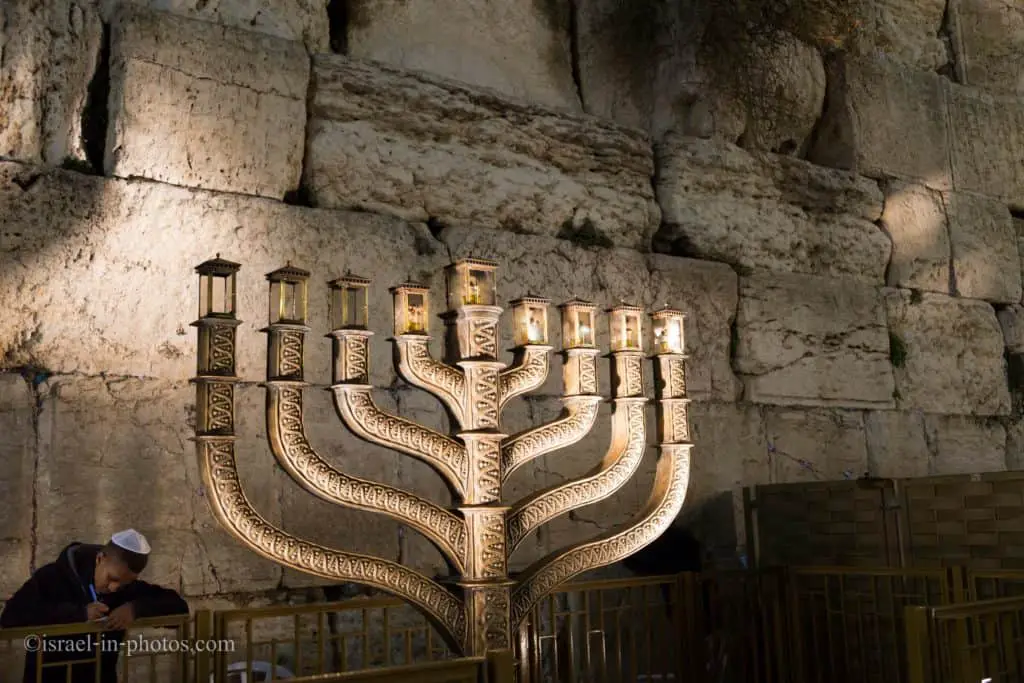
Tours
On the official site, you can find various tours, both virtual reality and regular ones. The regular tours include walking under the Kotel and in the Old City. And the most popular tour is the Western Wall Tunnels. And this leads us to the next question.
How Tall is the Western Wall?
The section of the Kotel at the Prayer Plaza is 19 meters high. But let’s dive into the measurements a little deeper.
The Western Wall is 488 meters long.
In the past, the Western Wall rose to a height of 60 meters. Today, the highest point in the exposed section reaches a height of 40 meters above the bedrock of the eastern hill of Jerusalem (Mt. Moriah).
The section of the Western Wall that is visible at the Prayer Plaza is comprised of 46 layers of stone. Twenty-nine of these layers are exposed above ground and contain stones from different periods. The remaining seventeen layers are subterranean. This above-ground section reaches a height of 19 meters. However, the height of this section from its foundation to its peak is estimated at approximately 32 meters.
Source: official site
As you can see from the quote, the above-ground section reaches a height of 19 meters. And the height from its foundation to the peak is estimated at approximately 32 meters. That means that the Wall goes about 13 meters underground. Moreover, if we use 3 meters as the height of a typical modern floor, that means that by standing on the plaza, you are not positioned on the ground. Instead, you are on the fourth floor!
So what can be found beneath the plaza?
Western Wall Tunnels
The Western Wall of the Temple Mount is one of the most magnificent and significant remnants in Jerusalem from the days of the Second Temple, destroyed approximately 2,000 years ago.
The Western Wall stretches along almost half a kilometer, but today, the part visible to all at the Western Wall Plaza is a mere 70 meters of it. The tour of the Western Wall Tunnels allows visitors to reach the segments of the Wall hidden from view, and to touch the original and special stones that tell the story of the Jewish nation. Visitors to the Western Wall Tunnels walk through ancient and fascinating subterranean spaces with exquisite archeological findings, such as large stone arches, water pits, an ancient water aqueduct that ends at the Strouthion Pool, and more.
Source: official site
If you want to visit the tunnels, book tickets in advance. And you can do it through the official website. For more info, see Western Wall Tunnels.
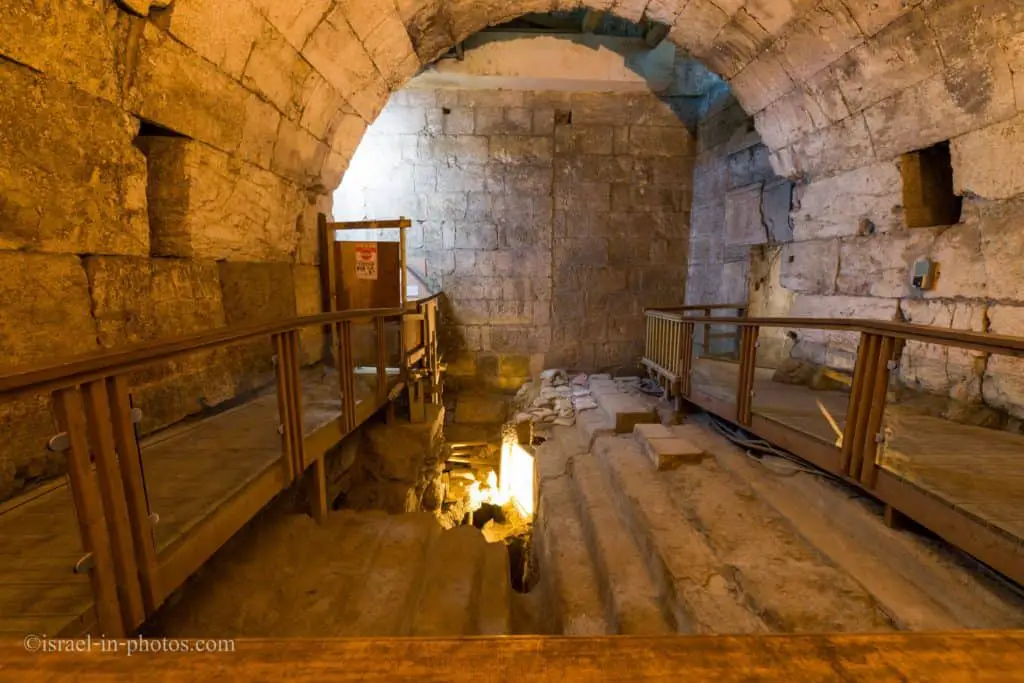
And now, let’s discuss several common issues and find out the connection between Star Trek and Kotel.
Taps and Drinking Water
There are two kinds of taps in the plaza – one for drinking and the other for purification.

When you see a tap, like in the photo above, you know it is not for drinking. The washing station is where Jews fill up a small silver or plastic double-handled jug and wash their hands. You can see the drinking fountain in the background of the photo above. Many people are near it, and there is also a sign in different languages. And in this context, I also want to mention the green glass fence in the top left corner. That is the entrance to the restrooms.
Are there any Time Constraints?
No. You can visit anytime. And stay there for as long as you want.
Walking Backwards
During your visit, you might see some people walking backward. Some Jews do not turn their back to the Western Wall too hastily (since they consider it disrespectful). Thus they start by walking backward, and only when their distance from the Kotel increases do they turn around.

Star Trek
In this post, we discussed the recommended times for a visit. And one of them was Birkat Kohanim. How was the hand gesture for “Live Long And Prosper” created? It is the sign that is used in Birkat Kohanim.
Here is a short video I found that tells the sign’s history.
Live Cam
Several live cameras show the Western Wall 24/7. And you can see the live streaming here.
Common Questions
The Western Wall is an ancient limestone wall and the last remnant of the Temple. And it is considered holy due to its connection to the Temple Mount.
Anybody who is allowed to enter Israel can visit the Western Wall.
Twice a year, Rabinovitch, Rabbi of the Western Wall, and his assistants collect the notes left in the Wall and bury them in the Jewish cemetery on the Mount of Olives.
Summary
The Western Wall is one of the most popular points of interest in the Old City of Jerusalem. You can go there anytime, but I suggest visiting it during one of the mentioned times (like Kabbalat Shabbat). Moreover, the Western Wall Tunnels and Behind the Scenes guided tours will let you see the city in a new light and upgrade your visit. I recommend it.
Have you ever been to the Western Wall? Tell us about your experience in the comments below.
That’s all for today, and I’ll see you in future travels!
Stay Tuned!
Additional Resources
Here are several resources that I created to help travelers:- Trip Planner with Attractions and Itineraries is the page that will help you create your perfect travel route.
- What is the Best Time to visit Israel? To answer this question, we will consider the weather, prices, holidays, festivals, and more.
- Information and Tips for Tourists to Israel will answer the most common questions tourists have about Israel (including safety, passports, weather, currency, tipping, electricity, and much more).
- Israel National Parks and Nature Reserves include a complete list, top ten, map, tickets (Israel Pass, Matmon, combo), and campsites.
- If you are looking for things to do, here are the pages for Jerusalem, Tel Aviv, Haifa, Sea Of Galilee, Akko (Acre), Eilat, Nazareth, Safed (Tzfat), and Makhtesh Ramon.

